The cosmic microwave background, or CMB, is the electromagnetic echo of the Big Bang, radiation that has been traveling through space and time since the very first atoms were born 380,000 years after our universe began. Mapping minuscule variations in the CMB tells scientists about how our universe came to be and what it’s made of.
To capture the ancient, cold light from the CMB, researchers use specialized telescopes equipped with ultrasensitive cameras for detecting millimeter-wavelength signals. The next-generation cameras will contain up to 100,000 superconducting detectors. Fermilab scientist and University of Chicago Associate Professor Jeff McMahon and his team have developed a new type of metamaterials-based antireflection coating for the silicon lenses used in these cameras.
“There are at least half a dozen projects that would not be possible without these,” McMahon said.
Metamaterials are engineered materials with properties that aren’t naturally occurring. The magic is in the microstructure — tiny, repeating features smaller than the wavelength of the light they are designed to interact with. These features bend, block or otherwise manipulate light in unconventional ways.
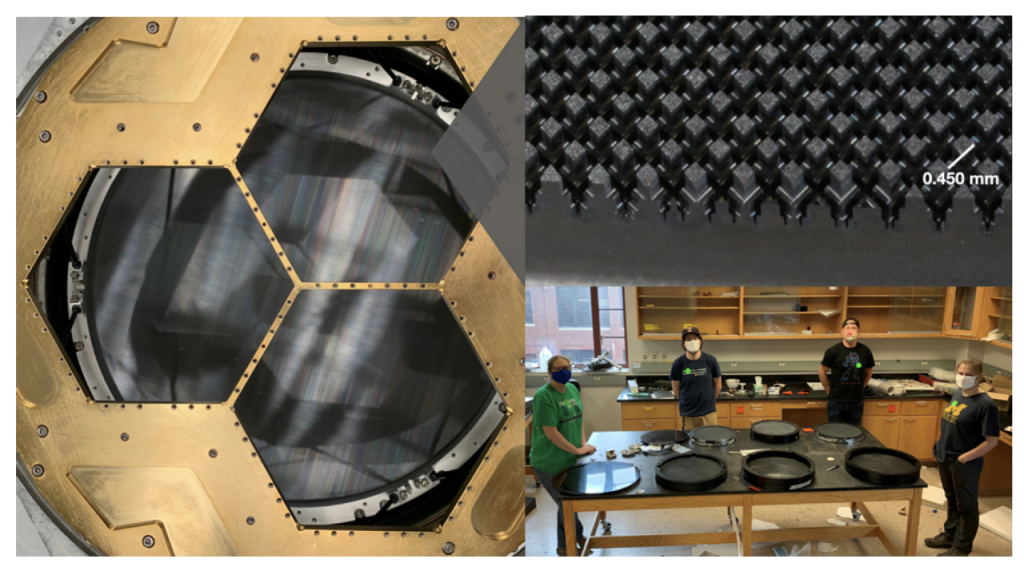
Left: One of the lenses developed by McMahon’s team is installed in a camera assembly. Top right: This shows a close-up view of the stepped pyramid metamaterial structure responsible for the lens’ antireflective properties. Bottom right: Members of the McMahon lab stand by recently fabricated silicon lenses. Photo courtesy of Jeff McMahon
Generally, antireflection coatings work by reflecting light from each side of the coating in such a way that the reflected particles of light interfere and cancel each other, eliminating reflection. For McMahon’s metamaterials, the “coating” is a million tiny, precise cuts in each side of each silicon lens. Up close, the features look like stepped pyramids — three layers of square pillars stacked on top of each other. The pillars’ spacing and thickness is fine-tuned to create the maximum destructive interference between reflected light.
“Light just goes sailing right through with a tenth of a percent chance of reflecting,” McMahon said.
The single-crystal silicon lenses are transparent to microwaves and ultrapure so that the light passing through the lens won’t be absorbed or scattered by impurities. Silicon has the necessary light-bending properties for getting light from the telescope onto a large array of sensors, and the metamaterial structure takes care of reflection. Because each lens is made from a single pure silicon crystal, they can withstand cryogenic temperatures (the detectors have to operate at 0.1 kelvins) without the risk of cracking or peeling like lenses with antireflective coatings made from a different material.
All told, these lenses are arguably the best technology available for CMB instruments, McMahon says.
“It’s not exactly that you couldn’t do the experiment otherwise,” McMahon said, but for the performance and durability demanded by current and next-generation CMB surveys, these lenses are the state of the art — and his team are the only people in the world who make them.
McMahon and his team began developing the technology about 10 years ago when they started working on a new type of detector array and realized that they needed a better, less reflective lens to go with it. The hard part, he says, was figuring out how to make it. Techniques existed for making micrometer-accurate cuts in flat silicon wafers, but nobody had ever applied them to a lens before. The first lens they made, for the Atacama Cosmology Telescope, called ACT, took 12 weeks to fabricate because of the huge number of cuts that needed to be made. Now with improved machines and automation at Fermilab, the process takes just four days per lens, and McMahon hopes they will be able to streamline it even further.
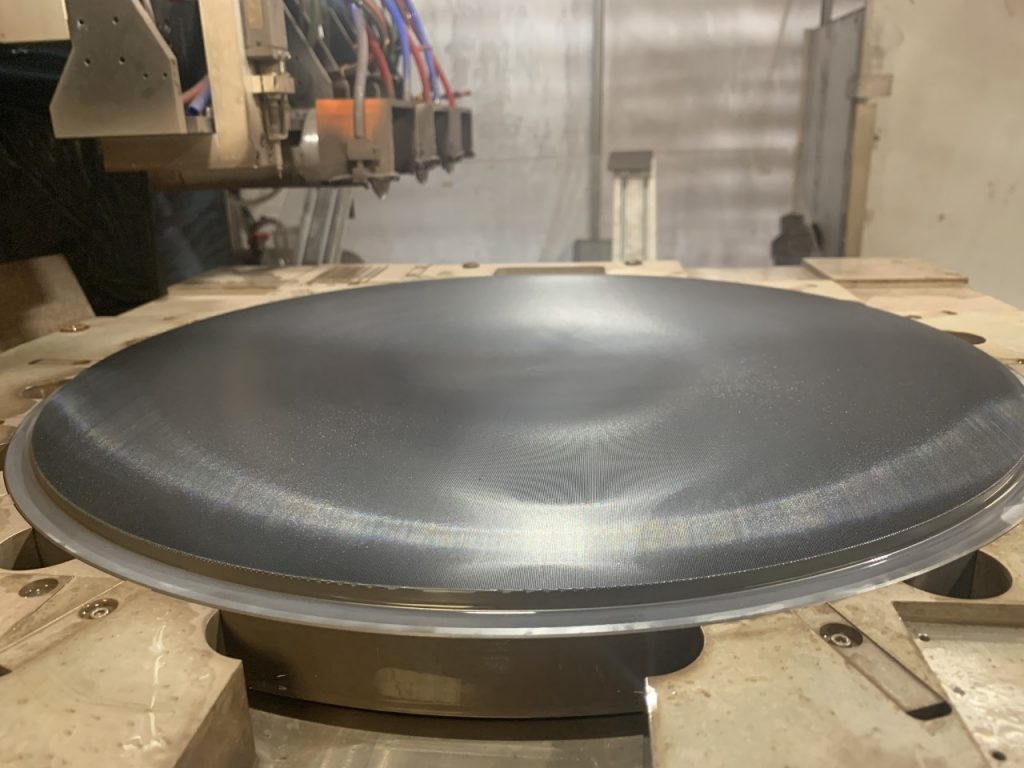
Jeff McMahon and his team have developed new techniques for working with curved lenses instead of flat silicon wafers for CMB telescope lenses. Photo courtesy of Jeff McMahon
Working at the University of Michigan until January 2020, McMahon’s team fabricated about 20 lenses for current CMB experiments including ACTPol, Advanced ACTPol, CLASS, TolTEC and PIPER. They are now producing lenses for the Simons Observatory, which will start collecting data next year. From there, they will begin making additional lenses for CMB-S4 (Cosmic Microwave Background Stage 4), a next-generation project of which Fermilab is a member. CMB-S4 is scheduled to begin collecting data in 2027 using 21 telescopes at observatories in Chile and the South Pole for the most detailed CMB survey yet.
“The second we finish a lens, it’s doing science, and that’s what makes it fun for me,” McMahon said. “All the metamaterial stuff is cool, but at the end of the day I just want to figure out how the universe began and what’s in it.”
McMahon compares CMB-S4 to opening a treasure chest full of gold and jewels. He and the other researchers contributing to it don’t know exactly what they’ll find in the data, but they know it will be valuable. Even if they don’t find primordial gravitational waves — one of the project’s major goals — the experiment will still shed light on cosmic mysteries such as dark energy, dark matter and neutrino masses.
What his team has achieved with their lens technology, McMahon says, is a testament to the outsize effect small efforts can have on big science.
“The endeavor is to begin to understand the beginning of the universe,” he said. “And the way we’re doing it is by figuring out how to machine little features in silicon.”
This work is supported by the Department of Energy Office of Science.
Fermilab is supported by the Office of Science of the U.S. Department of Energy. The Office of Science is the single largest supporter of basic research in the physical sciences in the United States and is working to address some of the most pressing challenges of our time. For more information, visit science.energy.gov.
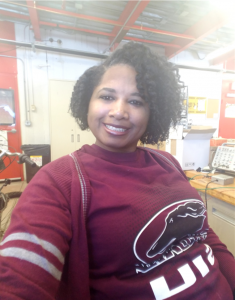
Roshanda Spillers makes sure that the experiments’ electronics are in working order and that the accelerators are well-maintained. Photo courtesy of Roshanda Spillers
How did you end up working at Fermilab?
I started working at the lab in January of 1998, soon after I had graduated from college with an associate’s degree in electronics and a bachelor’s of science in electrical engineering technology. I didn’t know anything about Fermilab back then, but I knew I wanted to work with electronics, so I put in an application on a whim and have been here ever since. It’s been over 20 years now.
What does a typical workday look like for you?
As an electronics technician in the Accelerator Division, I am part of the team responsible for making sure that the power supplies are operational for the different types of experiments done around the lab. I test various electronics, like transformers, voltage regulators, and circuit boards, to ensure there are no issues or glitches. My group functions sort of like a fire department in a way — we’re here on-call to troubleshoot whenever something goes wrong.
We also work on improving equipment currently in use by the particle accelerators. During beam shutdown periods, I’m mostly busy with maintenance work that keeps things running smoothly. But when the beam is turned on, we’ll work on further developing accelerator technologies by building new machinery that will get installed during the next shutdown.
What is the most rewarding part of working at Fermilab?
The best part is that I am able to supplement my on-the-job experience with educational opportunities. Fermilab has an excellent tuition assistance program that I use to enhance the work I do in my current position. Since working here, I have earned additional bachelor’s degrees in information technology and technical resource management, as well as an associate’s degree in computer support.
So you hold five degrees in total — that’s impressive! Are you working toward anymore?
I’m currently doing my master’s degree in quality engineering. And I can tell you without a doubt that this is not my last one. I’m getting my Ph.D., too. I’m not sure in what field yet, but at my last graduation I saw the doctoral students being hooded, and I immediately thought, “That’s next!”
As a recent grandmother of a three-month-old girl, I also want to pursue a Ph.D. to set an example for her: that no matter what, she can reach for her dreams and make them happen.
What advice would you give others who wish to follow in your footsteps?
Don’t take no for an answer and never give up. You don’t want to look back and wish you would have done something. If you really want to do it, just go for it! Never let anything get in your way.
When not at the lab or in class, how do you like to spend your time?
I am always doing something for my family. I think it’s important to take care of my elders because someday, I will be where they are now.
I also like to sew. I’ve made a bridesmaid’s dress and my own custom version of a bed-in-a-bag — a twin size blanket with a travel-size pillow.
And over the past few years, I started learning how to play the piano. It’s never too late to learn! I took lessons and performed in recitals, even though the other students were much younger than me. I got up there and played anyway because I’m pursuing my goals no matter what. Nothing beats a failure but a try.
Fermilab’s accelerator complex is supported by the U.S. Department of Energy Office of Science.
Fermilab is supported by the Office of Science of the U.S. Department of Energy. The Office of Science is the single largest supporter of basic research in the physical sciences in the United States and is working to address some of the most pressing challenges of our time. For more information, please visit energy.gov/science.
Fermilab scientists have been conducting experiments to look for quantum fluctuations of space and time at the smallest scale imaginable according to known physics. At this limit, the Planck length, our classical notions of space and time break down.
Imagine the ratio of the size of the universe compared to a speck of dust. That’s about how big the speck of dust is compared to the Planck length, 10-33 centimeters. The Planck time is how long it takes light to travel that distance.
Quantum mechanics tells us that everything is constantly fluctuating on small scales, but Planck-scale jitters of space and time themselves are so small that they’ve never been measured in the laboratory. Better understanding movement at the Planck scale may help physicists answer a basic and important question: Why do things appear to happen at definite times and places?
This space-time property, sometimes called simply “locality,” is indeed pretty basic. Definite places and times are supposed to be what space-time is made of — the very fabric of reality.
It has long been thought that the Planck scale is too small to study in any experiment, but about 10 years ago we decided to try it anyway. It’s possible that Planck-scale quantum uncertainties of space-time add up over the time it takes light to cross an experiment, so an impossibly small effect becomes merely very hard — rather than impossible — to detect. So, we built an apparatus called the Fermilab Holometer to look for very small fluctuations in widely separated locations.
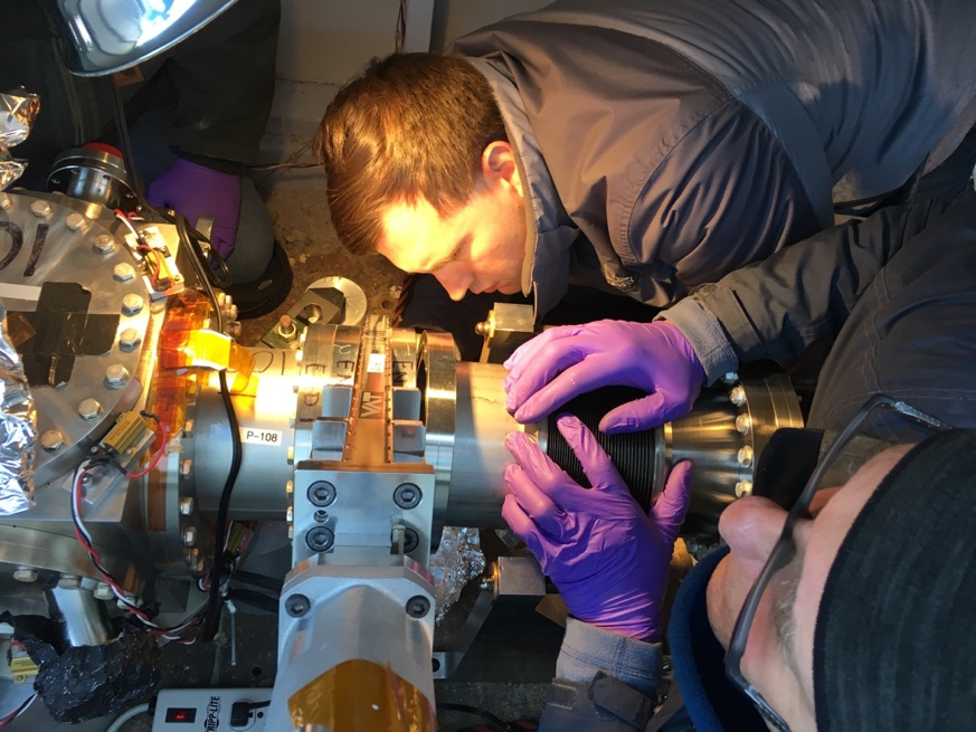
On Dec. 20, 2016, University of Chicago scientists Jonathan Richardson and Stephan Meyer work on the final assembly of the newly reconfigured Holometer vacuum system, which is inside an rough enclosure made of plywood, on a platform made of a steel slab recycled from Fermilab’s boneyard. The steel cube at the left holds the end mirror of one of the Holometer interferometers. Photo: Craig Hogan, Fermilab
Quantum matter and space-time: two world-systems sharing one unexplained reality
A quantum system is anything made of matter and energy, and nothing in it happens at a definite place and time until it is measured. Space-time seems to be just the opposite: Everything happens locally at a definite place, but its properties can be measured only nonlocally, that is, by comparing what happens in different places.
Somehow, these two different world-systems — quantum matter and space-time — share and interact in the same real physical world. Local absolute space directly affects matter, as anyone can see by spinning a top or experience by getting dizzy on a merry-go-round. Because matter is the source of gravity, it obviously affects space and time. Gravitational waves, which are made of pure space-time, carry energy and information, even through “empty” space, and matter can turn into pure space-time, in the form of black holes. But nobody understands exactly how quantum stuff relates to space and time.
The reason it’s easy to forget about quantum space-time in everyday life, and even in most Fermilab experiments, is that it doesn’t affect anything we actually measure. Although there must be some quantum uncertainty to space-time itself, it becomes fatal to standard theory only below the length where single quantum particles form black holes. This is the tiny scale we call the Planck length.
The Holometer’s success in measuring nothing
On a modest, 40-meter scale, the Holometer resembles giant detectors, such as the Laser Interferometer Gravitational-Wave Observatory in Hanford, Washington, and Livingston, Louisiana, that are used to detect gravitational waves from distant objects. Like LIGO, it uses mirrors and light — laser interferometers — to measure the shaking of space and time. In the Holometer, the laser light and mirrors, taken together as a system, become a nonlocal quantum object 40 meters long in one direction and 40 meters in another. They create an output signal that depends on quantum differences in the mirror positions. We can measure fluctuations from random changes of relative position of only one Planck length every Planck time if they are coherently correlated on the scale of the apparatus.
We published the results of our first experiment several years ago. In one sense the experiment was a big success, since we succeeded in measuring nothing with an unprecedented precision: With some kinds of Planck-scale jitters, we would have seen a big effect. But we found no such shaking. It was quiet.
However, that experiment did not rule out all kinds of fluctuating motion in space-time. For example, because the arms of its interferometers were straight, the laser light would not be affected if the apparatus shook with a purely rotational motion: The mirrors would move sideways relative to the beam instead of along it.
Searching for Planck-scale twists in space-time
In general relativity, rotating matter drags space-time along with it. In the presence of a rotating mass, the local nonrotating frame, as measured by a gyroscope, rotates relative to the distant universe, as measured by distant stars. It could well be that quantum space-time has a Planck-scale uncertainty of the local frame, which would lead to random rotational fluctuations or twists that we would not have detected in our first experiment, and much too small to detect in any normal gyroscope.
So, we did a new experiment. We rebuilt the apparatus in a new shape. We added extra mirrors to steer some of the laser light in different direction, so the signal would respond to coherent rotational jitters or twists.
The new instrument is an incredibly sensitive gyroscope for very short durations, able to detect very small rotational twists over the fraction of a microsecond it takes light to cross it. We can detect shaking that changes direction randomly a million times a second, but that moves the opposite sides of the apparatus by only a billionth of a billionth of a meter — a speed much slower than continental drift. In our apparatus, that corresponds to randomly fluctuating twists of about one Planck length every Planck time.
We recently completed our final experiment with this reconfigured Holometer. Our final result is again no jitters, which can be interpreted as no Planck-scale twists, of a certain kind, in the fabric of space-time. It seems space-time at the Planck scale is very quiet indeed.
The reason to keep looking for these effects is that we may never understand how quantum space-time works without some measurement to guide theory. The Holometer program is exploratory. Our experiment started with only rough theories to guide its design, and we still do not have a unique way to interpret our null results, since there is no rigorous theory of what we are looking for. Are the jitters just a bit smaller than we thought they might be, or do they have a symmetry that creates a pattern in space that we haven’t measured? New technology will enable future experiments better than ours and possibly give us some clues to how space and time emerge from a deeper quantum system.
We recently published a paper on our findings in the arXiv.
Craig Hogan is a Fermilab scientist and a professor of astronomy and astrophysics at the University of Chicago.
The Office of Science is the single largest supporter of basic research in the physical sciences in the United States and is working to address some of the most pressing challenges of our time. For more information, visit science.energy.gov.
The U.S. Department of Energy has formally approved the start of execution of the High-Luminosity LHC Accelerator Upgrade Project being carried out at eight U.S. institutions.
The approval, known as Critical Decision 3, or CD-3, is the endorsement by DOE to proceed with the full production of the U.S. contribution to the high-luminosity upgrade of the Large Hadron Collider, or HL-LHC, at the European laboratory CERN.
Fermilab leads the U.S. upgrade effort, which comprises two cutting-edge technologies: accelerator magnets and cavities. Under the HL-LHC Accelerator Upgrade Project, or AUP, the U.S. collaborators will contribute 16 magnets to dramatically focus the LHC’s near-light-speed particle beams to a tiny volume before colliding. The collaborators are also contributing eight superconducting cavities, radio-frequency devices designed to manipulate the powerful beams. (They will also provide four spare magnets and two spare cavities.)
With CD-3 approval, AUP collaborators can now move full-speed-ahead building and delivering the crucial components. The new instruments will enable a giant leap in the number of particle collisions at the future HL-LHC, a 10-fold increase compared to the current LHC.
The high-luminosity upgrade to the Large Hadron Collider will enable physicists to study particles such as the Higgs boson in greater detail. And the increase in the number of collisions could also uncover rare physics phenomena or signs of new physics.
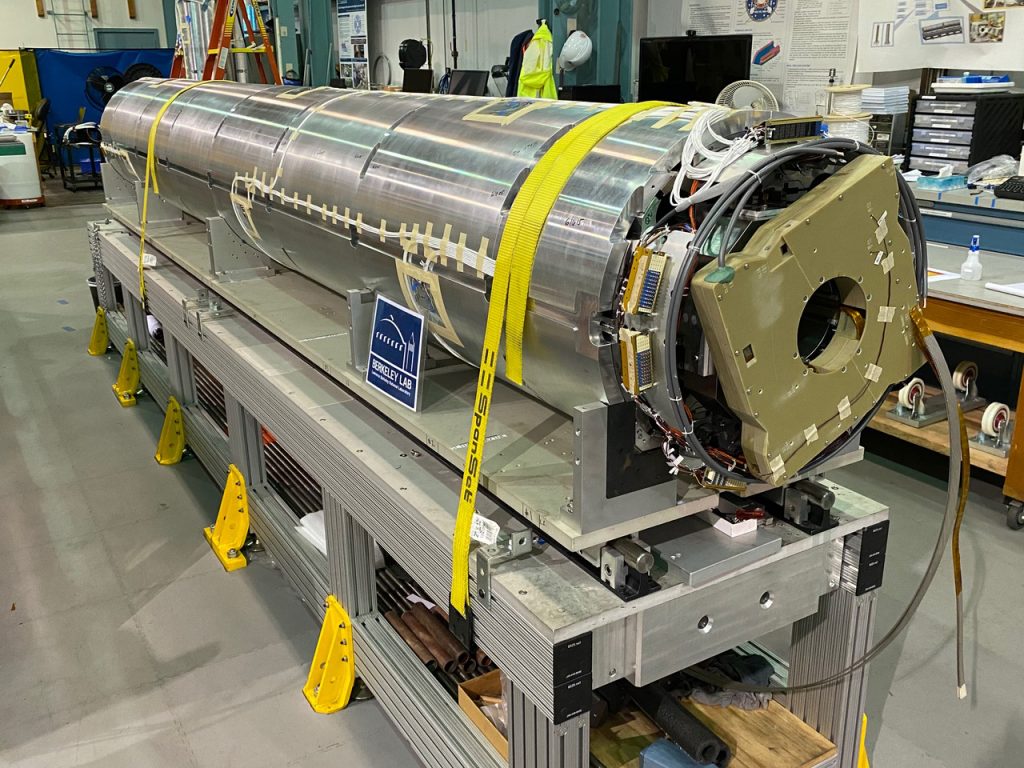
The HL-LHC Accelerator Upgrade Project magnets use conductors made of niobium-tin to generate a stronger magnetic field compared to predecessor technology. These world-record-setting magnets will have their debut in the HL-LHC: Its run will be the first time that U.S.-built niobium-tin magnets will be used in a particle accelerator for particle physics research. Photo: Dan Cheng, Lawrence Berkeley National Laboratory
“Gaining DOE’s endorsement to move to full production is a huge achievement. Knowing what it means for the future of particle physics — for the new physics that the HL-LHC will reveal and for future accelerators enabled by these technologies — makes it even more gratifying,” said Giorgio Apollinari, Fermilab scientist and HL-LHC AUP project manager. “I congratulate the entire AUP team on the milestone. They have been instrumental in ensuring the development and technical successes of the leading-edge technologies needed for the HL-LHC.”
The AUP is supported by the DOE Office of Science. The AUP team consists of six U.S. laboratories and two universities: Fermilab, Brookhaven National Laboratory, Lawrence Berkeley National Laboratory, SLAC National Accelerator Laboratory, Thomas Jefferson National Accelerator Facility (all DOE national laboratories), the National High Magnetic Field Laboratory, Old Dominion University and the University of Florida.
The AUP magnets use conductors made of niobium-tin to generate a stronger magnetic field compared to predecessor technology. These world-record-setting magnets will have their debut in the HL-LHC: Its run will be the first time that U.S.-built niobium-tin magnets will be used in a particle accelerator for particle physics research.
The 16 magnets will be installed in eight cryoassemblies — cooling and housing units that enable the magnets’ superconductivity.
“It is very exciting to see this cutting-edge magnet technology, which is enabling breakthrough science at the LHC, enter the production phase after the successful tests of our first magnets and with the approval of CD-3,” said scientist Kathleen Amm, the Brookhaven representative for the Accelerator Upgrade Project and director of Brookhaven’s Magnet Division. “The incredible talent across our national laboratories working seamlessly has made this possible.”
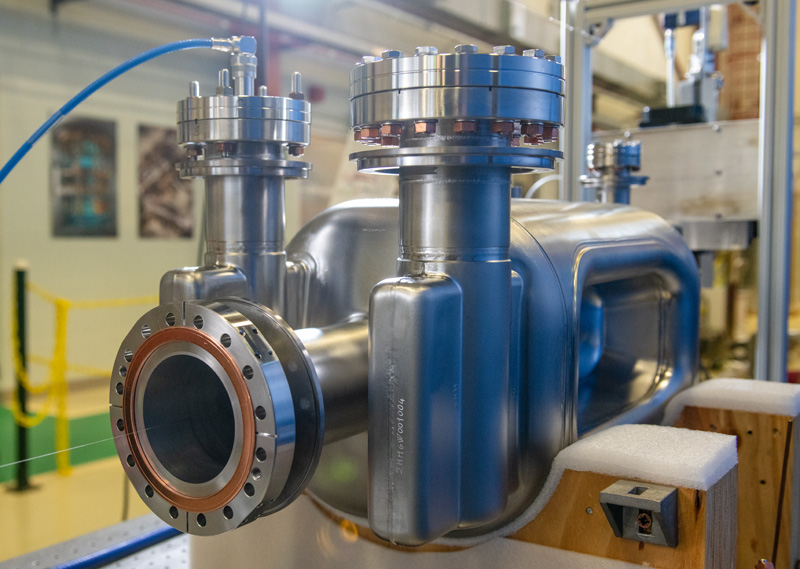
The operation of crab cavities like this one in the High-Luminosity LHC will be the first application of Fermilab superconducting radio-frequency technology — building upon critical contributions from Jefferson Lab, Old Dominion University, SLAC and industrial partners — in a particle-physics-dedicated accelerator. Photo: Ryan Postel, Fermilab
The AUP accelerator cavities, made of niobium, are a type known as “crab cavities,” manipulating the beam in a particular way to increase the likelihood of particle collisions. While Fermilab high-performance superconducting cavities have already been put to good use in accelerators such as XFEL in Germany or LCLS-II at SLAC National Accelerator Laboratory, the operation of these crab cavities in the HL-LHC will be the first application of Fermilab superconducting radio-frequency technology — building upon critical contributions from Jefferson Lab, Old Dominion University, SLAC and industrial partners — in a particle-physics-dedicated accelerator.
At the Large Hadron Collider, beams of protons race in opposite directions around the collider’s 17-mile circumference, colliding at high energies at four specific interaction points along the way. Scientists study the collisions to better understand nature’s constituent components and to look for exotic states of matter, such as dark matter.
The HL-LHC AUP magnets and cavities will be positioned near two of the LHC’s collision points — the ATLAS and CMS particle detectors. These giant, stories-high instruments are also being upgraded to take full advantage of the HL-LHC’s more rapid-fire collisions.
Over the course of the HL-LHC Accelerator Upgrade Project, the AUP team has seen one success after another, hitting both technological and project milestones according to the schedule established in 2015, says Apollinari. The U.S. collaboration’s first focusing magnet, completed last year, met or exceeded specifications.
“Building such an ambitious machine requires not only vision but discipline in carrying it out — tight, transparent, respectful coordination with partners, including with funding agencies and the independent reviewers,” Apollinari said. “The achievement is not only that we received CD-3 approval, but how we got here. We met our goals on a timescale that was put down on paper five years ago. That’s thanks to incredible teamwork of everyone involved.”
Fermilab, Brookhaven National Laboratory and Lawrence Berkeley National Laboratory are currently building the components and plan to begin delivering the first magnet cryoassembly by late 2021 for critical tests. Components will be installed in the HL-LHC from 2025 to early 2027. The HL-LHC is expected to start operations in 2027 and run through the 2030s.
“HL-LHC is a truly global scientific and engineering undertaking that will usher in a new era of research and discovery in particle physics. AUP plays a critical role in making this possible,” said Fermilab Director Nigel Lockyer. “The technologies developed by AUP will be important not only for the operation of HL-LHC, but also for the viability of future hadron colliders and the future of the field of particles — beyond the end of the HL-LHC’s run.”
Learn more about the LHC Accelerator Upgrade project, the AUP focusing magnets and the AUP cavities.
Fermilab is supported by the Office of Science of the U.S. Department of Energy. The Office of Science is the single largest supporter of basic research in the physical sciences in the United States and is working to address some of the most pressing challenges of our time. For more information, please visit energy.gov/science.
